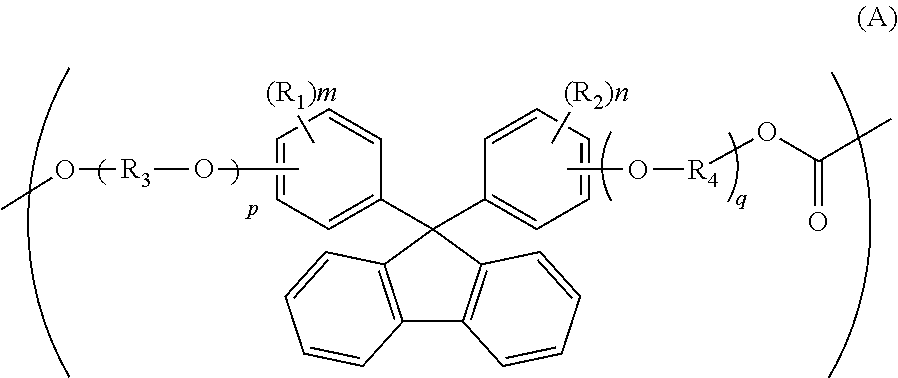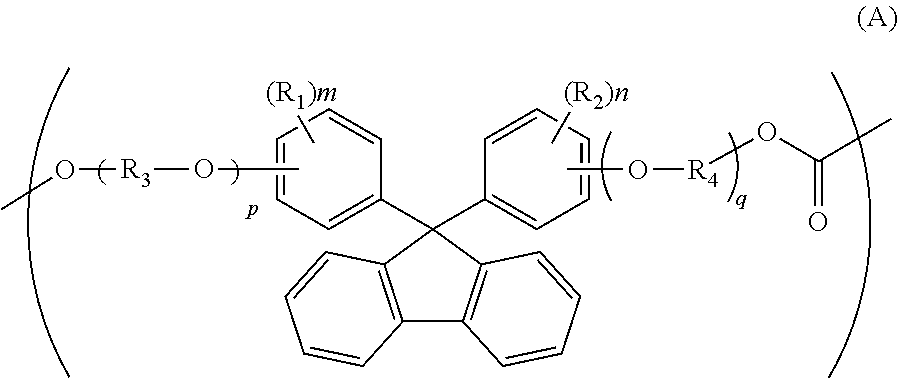Optical film
- Summary
- Abstract
- Description
- Claims
- Application Information
AI Technical Summary
Benefits of technology
Problems solved by technology
Method used
Image
Examples
example 1
[0188]72.32 Parts of isosorbide (to be abbreviated as “ISS” hereinafter), 80.24 parts of 9,9-bis(4-hydroxy-3-methylphenyl)fluorene (to be abbreviated as “BCF” hereinafter), 154.61 parts of diphenyl carbonate and 1.8×10−2 part of tetramethylammonium hydroxide and 1.6×10−4 part of sodium hydroxide as catalysts were heated and melted at 180° C. under nitrogen atmosphere. Then, the degree of reduced pressure was adjusted to 13.4 kPa over 30 minutes. Then, the temperature was elevated to 260° C. at a rate of 60° C. / hour, and it was maintained at this temperature for 10 minutes. Then, the degree of reduced pressure was adjusted to 133 Pa or lower over a period of 1 hour. The reaction was carried out with stirring for a total time period of 6 hours.
[0189]After completion of the reaction, dodecylbenzenesulfonic acid tetrabutylphosphonium salt having a molar amount 4 times the catalyst amount was added to deactivate the catalysts, and a reaction product was discharged from the bottom of the ...
example 2
[0191]An aromatic-aliphatic copolycarbonate was obtained in the same manner as in Example 1 except that 68.19 parts of ISS, 90.94 parts of BCF and 154.61 parts of diphenyl carbonate were used. The thus-obtained pellets had a viscosity average molecular weight of 19,200. Its compositional ratio was measured on the basis of NMR. The compositional ratio was BCF / ISS=33.7 / 67.3, and the deviation thereof from the charged amount ratio was as small as 0.3.
[0192]The copolycarbonate was dissolved in methylene chloride to prepare a dope having a solid content of 19% by weight. A cast film (thickness 68±0.8 μm) was formed from the dope by a known method. A sample having a size of 50 mm×10 mm was taken from a 80±0.8 μm thick portion in the vicinity of the center of the thus-obtained film, and the sample was evaluated for a photoelastic coefficient and a Tg in the same manner as in Example 1. A film taken in the same manner as in Example 1 was monoaxially stretched 2.0 times at Tg+10° C. in the s...
example 3
[0193]An aromatic-aliphatic copolycarbonate was obtained in the same manner as in Example 1 except that 72.32 parts of ISS, 93.09 parts of 9,9-bis[4-(2-hydroxyethoxy)phenyl]fluorene (to be abbreviated as “BPEF” hereinafter) and 154.61 parts of diphenyl carbonate were used. The thus-obtained pellets had a viscosity average molecular weight of 19,600. Its compositional ratio was measured on the basis of NMR. The compositional ratio was BPEF / ISS=29.8 / 70.2, and the deviation thereof from the charged amount ratio was as small as 0.2.
[0194]A film (thickness 83±0.8 μm) was prepared in the same manner as in Example 1. The obtained film was evaluated for a photoelastic constant and a Tg in the same manner as in Example 1. A film taken in the same manner as in Example 1 was monoaxially stretched 2.0 times at Tg+10° C. in the same manner as in Example 1 to obtain a stretched film having a length of 200 mm, a width of 57 mm and a thickness of 64 μm. The stretched film was measured for a retarda...
PUM
| Property | Measurement | Unit |
|---|---|---|
| Nanoscale particle size | aaaaa | aaaaa |
| Nanoscale particle size | aaaaa | aaaaa |
| Nanoscale particle size | aaaaa | aaaaa |
Abstract
Description
Claims
Application Information
 Login to View More
Login to View More - R&D
- Intellectual Property
- Life Sciences
- Materials
- Tech Scout
- Unparalleled Data Quality
- Higher Quality Content
- 60% Fewer Hallucinations
Browse by: Latest US Patents, China's latest patents, Technical Efficacy Thesaurus, Application Domain, Technology Topic, Popular Technical Reports.
© 2025 PatSnap. All rights reserved.Legal|Privacy policy|Modern Slavery Act Transparency Statement|Sitemap|About US| Contact US: help@patsnap.com



